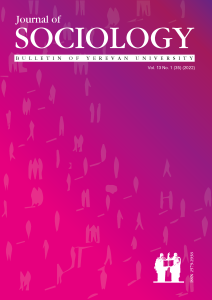Arshile Gorky’s life in USA. The hard way of search of identity
DOI:
https://doi.org/10.46991/BYSU:F/2022.13.1.024Keywords:
national identity, images, values, behavioral model, Vostanik Adoyan, Arshile Gorky, Ararat, Van, Khorgom, USA, racism, symbolic interactionismAbstract
The life and formation of the great Armenian artist Arshile Gorky in the USA and the search for his own identity is examined in the traditions of the sociological theory of symbolic interactionism, based on the analysis of the rich documentary material left by the artist himself and his contemporaries. The key to understanding the essence of the artist's identity is his statements about himself as a "child of Ararat", an artist who carries in himself the values of the images and colors of the lost homeland (Van, Khorgom). An analysis of the history of the search for identity shows that despite the socio-cultural problems caused by racist policies and the reality of early 20th century American society, Arshile Gorky remained faithful to his purpose and mission: in his paintings he was able to preserve the image of the lost homeland. He used his brush to recreate the image of Western Armenia. He did not change his national identity, and remaining faithful to the inherited principles nurtured himself "mighty as a giant, but tender at heart, like a child". With his art, Arshile Gorky was able to achieve the freedom he strived for.
References
Burke, P. J. (1980). The self: Measurement implications from a symbolic interactionist perspective. Social Psychology Quarterly, 43, 18-29. Doi: https://doi.org/10.2307/3033745
Burke, P. (2020), Kivisto, Peter (ed.), "Identity", The Cambridge Handbook of Social Theory: Volume 2: Contemporary Theories and Issues, Cambridge University Press, vol. 2, pp. 63-78. Doi: https://doi.org/10.1017/9781316677452.005
Crossman, A. "Stigma: Notes on the Management of Spoiled Identity." ThoughtCo, Aug. 28, 2020, thoughtco.com/stigma-notes-on-the-management-of-spoiled-identity-3026757.
Gorky Adoian, A. (2005), Letters. Edited by Seyranouhi Geghamyan. Graber, Yerevan 2005
Gorky, A. (2018) The plow and the song. A life in letters and documents. Edited by Matthew Spender, Hauser and Wirth Publishers, Zurich.
Linville W., P. (1987). Self-complexity as a cognitive buffer against stress-related illness and depression. Journal of Personality and Social Psychology, 52, 663-676. Doi: https://doi.org/10.1037/0022-3514.52.4.663
Matossian N. (1998) Black angel. Alife of Arshile Gorky, Chatti & Windus, London.
McCall, G. J., & Simmons, J. L. (1978). Identities and interactions. New York: Free Press.
Morrione, T. (Spring 1988). "Herbert G. Blumer (1900-1987): A Legacy of Concepts, Criticisms, and Contributions". Symbolic Interaction. 11, Special Issue on Herbert Blumer's Legacy (1): 1-12. Doi: https://doi.org/10.1525/si.1988.11.1.1
Nickerson, C. (2021, Oct 12). Symbolic interactionism theory & examples. Simply Psychology. www.simplypsychology.org/symbolic-interaction-theory.html
Papazian, D. (2000) "Armenians in America". Journal of Eastern Christian Studies. University of Michigan-Dearborn, Volume: 52, Issue: 3-4 , p. 311-347. Doi: https://doi.org/10.2143/JECS.52.3.565605
Saulius Geniusas (2006), Is the Self of Social Behaviorism Capable of Auto Affection? Mead and Marion on the "I" and the "Me", The Chinese University of Honk Kong, p. 263. Doi: https://doi.org/10.1353/csp.2006.0021
Shibutani, Tamotsu (Spring 1988). "Blumer's Contributions to Twentieth-Century Sociology". Symbolic Interaction. 11 (1, Special Issue on Herbert Blumer's Legacy): 23-31. Doi: https://doi.org/10.1525/si.1988.11.1.23
Stryker, S. (1980) Symbolic interactionism: A social structural version. Menlo Park: Benjamin Cummings.
Tajfel, H. (1981). Human groups and social categories: Studies in social psychology. Cambridge: Cambridge University Press.
Teryan, A. (2002), Armenia: the cradle of creation and civilization, Preface. Yerevan. (Տերյան Ա., Հայաստանը արարչագործության և քաղաքակրթության բնօրրան, Երևան, 2002)
Theriault S., K. (2009) Rethinking Arshile Groky, Chapter 2, Construction of gender, self, and other. Penn State Press, p. 44.
Downloads
Published
How to Cite
Issue
Section
License
Copyright (c) 2022 Lyudmila Harutyunyan, Hripsime Dayan

This work is licensed under a Creative Commons Attribution-NonCommercial 4.0 International License.








